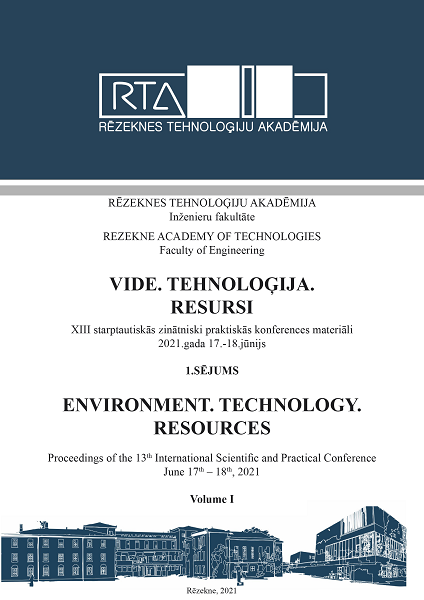STUDY OF THE DISTRIBUTION OF AIR TEMPERATURE IN A GREENHOUSE HEATED BY AIR TO AIR HEAT PUMP
DOI:
https://doi.org/10.17770/etr2021vol1.6521Keywords:
air temperature, air to air heat pump, greenhouse heatingAbstract
The temperature distribution inside the experimental greenhouse heated by air to air heat pumps and its impact on the growth and productivity of tomato plants were studied. Experimental greenhouse located at SIA Rītausma facility in South-East Latvia.
Two commercially available regular air to air heat‑pumps with a combined heat power of 10 kW were used. To measure the temperature distribution, 18 temperature sensors with solar radiation shields at different heights and positions among the plants were installed. Additional 4 temperature sensors were used to measure the air flow temperature at the heating elements. Reference air temperature was measured at an industrial production facility heated by a common gas heating system.
Temperature was found to be homogenous within 1 °C. Observed temperatures were up to 4 °C lower than set on the control unit of the heat pump. This discrepancy was compensated by higher set values for the controlling unit. As research showed the temperature stability was better than at the water-heated industrial facility at time slots when the sun was suddenly cleared from clouds.
The cooling of the experimental greenhouse by air conditioning during summer time was rather challenging for the tomato plants and productivity. 23% of plant stems died until the end of the season and the yield was 50% lower than in the reference greenhouse. The energy efficiency compared to the industrial facility was approx. 8 times better and the estimated CO2 emissions were 8-16 times smaller compared to gas heating. There were no increases of heating costs determined.
Further studies are needed to optimize the heating parameters and reach the desired greenhouse productivity.
Downloads
References
M. Canakci, N. Yasemin Emekli, S. Bilgin, N. Caglayan, “Heating requirement and its costs in greenhouse structures: A case study for Mediterranean region of Turkey”, Renewable and Sustainable Energy Reviews, vol. 24., , pp. 483–490, 2013.
L. Zhang, X. Hao, Y. Li, G. Jiang, “Response of greenhouse tomato to varied low pre-night temperatures at the same daily integrated temperature,” Hortiscience, vol. 45 (11), pp. 1654 – 1661, 2010.
IPCC. Climate Change 2014: Mitigation of Climate Change. Contribution of Working Group III to the Fifth Assessment Report of the Intergovernmental Panel on Climate Change [Edenhofer, O., R. Pichs-Madruga, Y. Sokona, E. Farahani, S. Kadner, K. Seyboth, A. Adler, I. Baum, S. Brunner, P. Eickemeier, B. Kriemann, J. Savolainen, S. Schlömer, C. von Stechow, T. Zwickel and J.C. Minx (eds.)]. Cambridge University Press, Cambridge, United Kingdom and New York, NY, USA, 2014.
Y. Tong a, T. Kozai, N. Nishioka, K. Ohyama, “Greenhouse heating using heat pumps with a high coefficient of performance (COP),” Biosystem Engineering, vol. 106., pp. 405 - 411, 2010.
T. Kozai, K. Ohyama, Y. Tong, P. Tongbai, N. Nishioka, “Integrative environmental control using heat pumps for reductions in energy consumption and CO2 gas emission, humidity control and air circulation,” Scientia Horticulturae, vol. 893, pp. 445-449, 2011.
R. S Atlason, G. V. Oddsson, R. Unnthorsson, “Heat pumps in subarctic areas: current status and benefits of use in Iceland,” Int J Energy Environ Eng., vol. 8, pp. 283–291, 2017. Available: SprigerLink, https://link.springer.com/article/10.1007/s40095-017-0244-6 [Accessed February 26, 2021], https://doi.org/10.1007/s40095-017-0244-6
A. Grubbauer, J. Flucha, C. Brunnera, T. Ramschaka, V. Wilkb, T. Flecklb, “Renewable and highly efficient energy systems through innovative combination of solar thermal and heat pump systems,” Chemical engineering transactions, vol. 70, pp. 745-750, 2018.
M. K. Mattinen, A. Nissinen, S. Hyysalo, J. K. Juntunen, “Energy use and greenhouse gas emissions of air-source heat pump and innovative ground-source air heat pump in a cold climate,” Journal of Industrial Ecology, vol. 19(1), pp. 61-70. 2014. Aviable: Wiley Online Library, https://onlinelibrary.wiley.com/doi/abs/10.1111/jiec.12166 [Accessed March 8, 2021],
https://doi.org/10.1111/jiec.12166
D. P. Rubanga, K. Hatanaka, S. Shimada, “Development of a simplified smart agriculture system for small-scale greenhouse farming, “ Sensors and Materials, vol. 31, No. 3, pp. 831-843, 2019.


